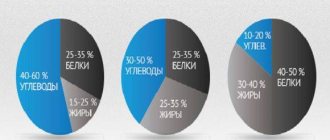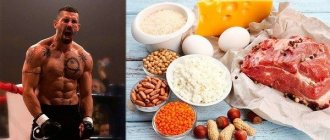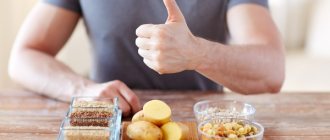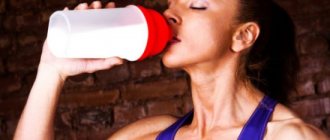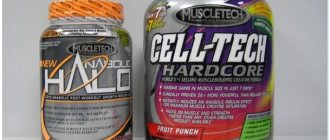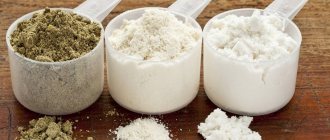Protein diet for weight loss - nutritional features
People have long noticed the effect of weight loss when following a protein diet.
Already in the nineteenth century, a book was published in Europe telling about the benefits of protein. And in the modern world, the most famous author of a protein weight loss program is Dr. Dukan, thanks to whom the famous Kremlin diet was also developed. There are a lot of sources on the Internet that tell you what a high-protein diet is. But despite this abundance, it is not always possible to understand the meaning of the information. And all because a very large number of facts are distorted. You can often see an article where it is written that a protein diet is an excellent solution for a nourishing, tasty diet, as well as getting rid of extra pounds. In fact, this is not entirely true. And this program is not suitable for everyone who is losing weight. Therefore, before you start losing weight, you should contact specialists so that they can help you choose the right diet for you.
To broaden your general horizons, get acquainted with some features of protein nutrition. You can follow the program for no more than two weeks. To consolidate the results obtained, exit the diet gradually. To do this, try eliminating fried fatty foods and sweets from your diet.
Repeating the course is possible no earlier than six months later. During this time, the lost kilograms not only manage to return safe and sound, but also often bring new ones with them.
Due to the increased functions of the excretory system during the period of protein nutrition, observe the drinking regime. Drink the required amount of still water.
Try to count calories. Their deficiency, as well as their excess, can cause harm, causing disturbances in the functioning of internal organs. The amount of calories consumed should range from 1200.
Duration of the BUTCH diet and how to get out of it correctly
The duration of the diet ranges from 7 to 28 days. During this time you can lose weight:
- in 7 days – up to 5 kg;
- in 10 days – up to 7 kg;
- in 14 days – up to 10 kg;
- in 28 days – up to 15 kg.
The result directly depends on the weight. The higher it is, the more active the reduction in body weight. At the same time, the BCH system allows you to achieve your physiological weight, and not lose more weight than normal, as during hunger strikes.
To maintain the results, you need to exit the diet correctly. For the last week, change the system daily (protein, carbohydrate, mixed period and again). Then begin to gradually introduce foods from your usual table. Add 1-2 new dishes to your diet every day, including fats. And only a month after completing the diet you can return to your usual diet.
The role of proteins for the body
Protein takes part in all vital processes. Proteins can be of plant or animal origin. The second type is of greatest value. It is absorbed by the body by 98% and contains essential amino acids. Vegetable protein contains only protein, and its digestibility reaches only 60%.
It is important for a person who is losing weight to have a balanced diet. The optimal menu should contain 60% animal protein and 40% plant protein.
Protein functions:
- Construction;
- Hormonal;
- Catalytic;
- Transport;
- Protective.
How proteins affect weight loss
Increased consumption of protein products affects the acceleration of metabolic processes and changes in appetite. Protein-rich foods leave you feeling full for a long time after eating. Therefore, hunger does not often bother a person. The reason, surprisingly, does not lie in the high calorie content. Proteins provoke the production of special hormones that suppress hunger, helping the feeling of fullness last longer.
Another ability to help you lose weight is to speed up your metabolism. By increasing your metabolic rate, excess calories are burned faster.
Is it possible to lose weight on a protein diet and by how much?
You won't have to wait long for results. The first noticeable changes can be seen within a few days. Although the initial weight affects the number of kilograms lost, a person can lose about 4 in a week.
To prevent your skin from becoming flabby after losing weight, take time for physical training. This way the body will remain toned.
BUCH diet rules
To lose weight with protein-carbohydrate alternation, you must adhere to the following rules:
- The duration of the diet ranges from 7 to 28 days. It is not recommended to adhere to the BUCH power system for a longer period of time.
- Physical activity is required during the diet. Otherwise, protein will begin to be deposited on the stomach and waist.
- Avoid spices that increase appetite and cause fluid retention in the body. Ideally, you should stop adding salt to your dishes, but if that doesn’t work, then at least limit the amount of salt you consume.
- Don't eat foods containing sugar. This also applies to packaged juices. But freshly squeezed juices are possible.
- Food must be prepared by boiling, stewing, baking or steaming. Fried and smoked foods are completely excluded.
- Drink at least 1.5 liters of water per day. If you lead an active lifestyle, your body requires 2.5 liters of fluid per day.
The classic diagram of the BUCH system looks like this:
- 2 days of protein;
- 1 day carbohydrate;
- 1 day mixed;
- repetition of the course.
But you can cancel the mixed day, alternating 2 days of protein and the same amount of carbohydrates.
Protein diet rules
- In addition to protein foods, the diet should include additional nutrients.
- Eat small meals at least five times a day. It is better to have a morning meal an hour after waking up. Eat 2-3 hours before going to bed at night.
- Limit high-sugar fruits to two per day.
- Nutritionists recommend eliminating sugary carbonated drinks due to the large amount of carbohydrates they contain.
- The daily intake of animal fat is no more than 40 g.
- Try to maintain a drinking regime.
- Physical activity will be a good addition to your diet.
- Additionally, take vitamin complexes.
Diet
The diet includes mandatory components: breakfast, second breakfast, lunch, afternoon snack and dinner.
It is better to have a morning meal no less than an hour after waking up. Have dinner 2-3 hours before bedtime. Between breakfast and lunch, porridge made from slow-digesting carbohydrates is perfect as a snack. These cereals include: buckwheat, oatmeal.
As mentioned above, it is better to avoid sweet fruits. No more than two pieces are allowed. Nutritionists recommend including vegetable salads in your diet in the afternoon. Potatoes are prohibited in any form due to their high starch content.
To avoid a psychological breakdown, experts recommend allowing yourself one forbidden dish once a week. Treat yourself to your favorite, even unhealthy food, while continuing to move forward towards your goal.
How to cook meals
To prepare tasty diet food, it is not at all necessary to use sauces, salt, or flavor enhancers. Try to follow some rules that will help during your weight loss period.
Cooking nuances:
- When preparing salads, you will have to give up mayonnaise. Lemon juice, natural yogurt and kefir are good substitutes.
- Vegetable dishes can be prepared with the addition of small amounts of oregano, curry and ginger.
- When cooking meat, you can add pepper and garlic. When baking, you can use honey and mustard for the marinade.
- Fruits and berries should be consumed exclusively raw.
- Teas and fruit drinks are excellent drinks. Try to cook them without adding sugar.
To prepare protein foods without increasing the calorie content, you should avoid frying and oils. If you still need to fry food, it is better to use a non-stick frying pan. But it is more effective to give preference to boiling, stewing and baking.
Types of diets for mass gain
Depending on which foods a person prefers, diet options for weight gain will vary. There are three types: protein, carbohydrate and protein-carbohydrate. This also includes the energy and vegetarian diets.
Strict protein diet
Professional athletes adhere to a strict protein diet before upcoming competitions. It is aimed not only at gaining weight, but also at burning fat.
This diet involves a complete rejection of fatty foods and carbohydrates, but with the consumption of foods rich in protein. If a person’s priority is not cutting, but rather gaining weight, then such a diet will not suit him.
Protein-carbohydrate diet
A protein-carbohydrate diet is better suited for building muscle mass than others. The menu is designed in such a way that the body draws the energy it needs from carbohydrate foods and fat reserves, and takes building material for muscles from protein foods. Such diets do not involve strict prohibitions; they are suitable for everyone without exception.
Carbohydrate rotation diet
This diet option is gaining more and more popularity among people involved in sports every day.
It involves following 4 cycles:
- The menu for days 1 and 2 is low-carb. The amount of protein is 3-4 g/kg, carbohydrates - 1-1.5 g/kg.
- Menu 3 days: carbohydrates – 5-6 g/kg body weight, proteins – 1-1.5 g/kg body weight.
- Menu 4 days: proteins 2-2.5 g/kg, carbohydrates – 2-3 g/kg.
In the first days of the diet, the body uses up glycogen reserves and fat deposits. Muscles do not burn, since sufficient amounts of protein are supplied with food. When the second day comes to an end, the body begins to experience stress, as it receives a very limited amount of carbohydrates, so it begins to burn fat deposits more slowly, slowing down metabolic processes.
To speed up metabolism again, during the third day a person eats a sufficient amount of carbohydrate food. This misleads the body, and it continues to consume fat, accumulating glycogen.
The goal of the last day is to replenish glycogen reserves and prepare the body for a new diet cycle.
Vegetarian diet
Eating plant foods allows you to build muscle mass no worse than eating animal products. More protein-rich foods (nuts, grains, legumes, seeds) are introduced into the menu. The diet is supplemented with brewer's yeast and vitamin and mineral complexes. You need to eat often, but in small portions. To prepare dishes, you should use as many different products as possible. To prevent muscles from burning and gaining weight, you should eat food at least 8 times a day. In this case, 4 approaches to the table are basic, and another 4 approaches will be additional.
Energy diet
The Energy Diet from NL International is a nutrition system popular among athletes. The company produces products not only for gaining muscle mass, but also for losing weight.
Energydiet products are food supplements that must be consumed according to a specific schedule. It is compiled depending on the goal that a person pursues. It should be noted that the Energydiet course requires a very impressive financial investment. As for the effect, it can be achieved with the help of ordinary food products, but with a well-designed menu.
Pros and cons of a protein diet
In addition to fulfilling the main task of “getting rid of extra pounds quickly, but not for long,” this program also brings other benefits to the body.
- The condition of the skin improves.
- Removing toxins and harmful substances.
- Lack of hunger due to the long process of protein digestion.
- Ideal for athletes.
- As with everything, there are also disadvantages:
- Disorders of the gastrointestinal tract, manifested by constipation. To combat them, drink more water. In exceptional cases, you can resort to the use of laxatives.
- Unpleasant odor from the mouth.
- The cost of some ingredients, such as seafood, is quite high.
- With prolonged dieting, calcium deficiency develops.
- Due to a lack of carbohydrates, performance decreases.
Contraindications
- Anemia;
- Pregnancy and lactation periods;
- Kidney diseases;
- Pancreatic diseases;
- Diabetes;
- Gout;
- Diseases of the cardiovascular system;
- Individual protein intolerance;
- Liver diseases;
- Elderly or children's age.
For children
Any type of protein diet is prohibited for persons under the age of majority. This is explained by the fact that a growing human body must receive as many nutrients and vitamins as possible. The child’s diet during the period of active growth must be balanced in all parameters and ratios of BZHU.
During pregnancy and lactation
The reason why pregnant and lactating women should not follow a protein diet is similar. During pregnancy and lactation, a woman should receive a large amount of nutrients. This is necessary for the proper development of the fetus and child.
What is a protein diet
The protein diet, as the name implies, is based on the consumption of protein foods, while carbohydrate-containing foods are kept to a minimum. Result: minus 5-10 kilograms in just ten days. By the way, that’s exactly how long it lasts.
The opinions of doctors and nutritionists about it are divided. Some consider it almost a panacea for all ills, others point out its shortcomings, and still others confuse it with the Dukan diet (which is not entirely correct, although the latter is also based on the consumption of protein foods).
To understand all this, let's consider all the advantages and disadvantages of this method of nutrition.
Advantages
8 main advantages of the diet:
- A protein diet for weight loss is an ideal way to lose weight without suffering from constant hunger. This is possible due to the high protein content in the foods consumed.
- Ideal for athletes, as it allows you to maintain and build muscle relief while getting rid of excess subcutaneous fat.
- There is no “sagging skin” effect.
- At the same time, it cleanses the body.
- Improves metabolic processes and speeds up metabolism.
- With the right approach and following all the rules, it gives a lasting result.
- Allows you to use a tasty and rich menu.
- Lasts only ten days.
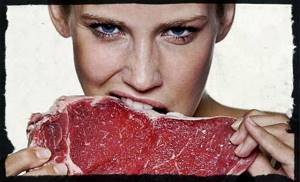
Flaws
The disadvantages of a protein diet are much less than the advantages:
- Most of the possible negative consequences are associated with non-compliance with the rules and diet (see below).
- Cannot be used for a number of diseases.
- Calcium is washed out of the body.
- Lethargy and weakness may appear in the initial stages.
Contraindications
The protein diet has a number of contraindications:
- kidney diseases;
- diabetes;
- period of lactation and pregnancy;
- for disorders and disturbances in the gastrointestinal tract;
- diseases of the cardiovascular system.
Types of protein diets
There are several types of protein programs, but their general essence is to consume large amounts of protein and limit fat.
Dukan
The method involves creating a diet of low-calorie foods. The volume of food eaten is not controlled due to the fact that you still won’t be able to eat a lot of protein foods. Due to the absence of these restrictions, the diet is easier to tolerate than many others. But let us remind you that it has nothing to do with proper - rational - nutrition.
The Dukan program consists of four stages:
- The attack is a difficult but effective period. At this phase, metabolic restructuring and active fat burning begin. In seven days you can lose about 4 kg. It is recommended not to continue the diet for more than ten days. It is allowed to eat low-calorie foods prepared without oils.
- A cruise is a gentle period, longer than the first one. Continue the second stage until the desired result is achieved. Here you can alternate a protein day with a vegetable day.
- Consolidation is a phase that implies the correct exit from the diet. It will take time for the person to gradually return to a normal diet. Refrain from sweets in large quantities, because it is difficult for the body to quickly adapt to carbohydrate metabolism. The consolidation phase lasts a long time, sometimes it can reach up to 150 days.
- Stabilization - the usual mode is followed here, but with new features. Stay hydrated, spend more time outdoors and exercise.
Malysheva
Malysheva’s program consists of a combination of the rules of fractional nutrition and a high-protein diet. The dietary menu is quite balanced and nutritious.
Malysheva gives recommendations to beginners:
- You need to have a positive attitude when starting a diet;
- You cannot suddenly switch to dietary nutrition;
- The daily amount of calories is 1200-1400;
- Maintaining split meals - three meals and two or three additional snacks;
- It is forbidden to go hungry.
If you exercise while following a diet, you are allowed to increase the number of calories to 1700 per day.
Sports low-carbohydrate diet
A sports weight loss program means a gradual reduction in the amount of fats and carbohydrates consumed. This system is often followed by athletes who need to emphasize muscle definition and get rid of fat deposits.
Main prohibited foods: sweets, alcohol, fruits. At the end of the diet, you can’t even eat honey.
It is important to remember that the more stringent the program, the more fluid you need to consume. If this rule is neglected, problems will certainly arise in the functioning of the digestive system, metabolic failures, and well-being will also worsen. And once a person begins to drink a lot of liquid, which washes out vitamins and microelements from the body, then their deficiency develops. To solve the problem, use specially designed vitamin complexes.
System rules:
- Get into the diet smoothly. With a sudden transition, the body will fall into a state of stress.
- The number of meals per day is 6 times.
- Drinking regime. The daily water intake is 30 ml per kg of body weight.
The diet consists of 10% fats, 20% carbohydrates, and the rest is proteins, the amount of which must be increased gradually.
Since athletes follow a diet, physical activity takes a certain place. It is best to combine strength training with cardio.
Nutrition for Muscle Growth: Basic Principles
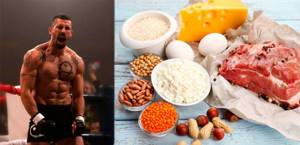
The energy expended by a person, replenished by eating food, is directly proportional to physical activity. Strength training requires several times more energy than normal human activity. And if you reduce your diet, the body will begin to experience a lack of nutrients. This will negatively affect both your well-being and the results of your classes.
Following a diet to increase muscle mass does not mean starving, but, on the contrary, consuming more calories than energy expended. This fact should not be taken as the only condition for such nutrition. A diet that promotes muscle gain should be balanced and built on six basic principles:
Fractional meals
You need to eat a lot, but in small portions throughout the day. This promotes the rapid absorption of food for energy, rather than for the accumulation of fat deposits. By eating fractionally, an athlete gains muscle mass rather than fat mass.
High calorie food
Each serving of food you eat should contain a lot of calories. The lower the energy value of food, the more often you will have to eat. About 70% of the daily diet, compiled by the nutrition program, must be made up of high-calorie foods.

Slow fats and carbohydrates
You need to exclude fast carbohydrates and fats from the menu - sweet fruits, confectionery and flour products. They require a long time to digest, which leads to the build-up of fat rather than energy. The body does not have time to spend most of the nutrients extracted from fast carbohydrates and fats to renew the expended energy, but sends it to “storage,” that is, to a fat depot.
Sufficient amount of water
A diet for gaining muscles speeds up metabolism and puts the body into a stressful situation, which can be avoided by following a drinking regime. You need to drink at least three liters of water per day. Failure to comply with this point can lead to dehydration, expressed by deterioration of well-being and stopping the growth of muscle mass.
Diet
Portions eaten before 16.00 should make up the majority of the daily diet. At a later time in the diet, foods with fast carbohydrates and fats should be avoided.
Sports diet
Involves mandatory intensive training. Otherwise, all the calories you consume will turn into fat and not into lean muscle mass. On training days, you need to eat 2 hours before and after training. Accelerating the process of muscle growth is facilitated by additional intake of sports supplements.
Gain muscle mass on a budget.
Protein drinks for fast weight loss
Protein shakes are mainly prepared from sports nutrition with the addition of liquid. But not every person can afford sports nutrition, because professional drinks can hardly be called budget. Let's look at homemade cocktail options:
- First option. To prepare the drink you will need: 350 ml of milk, one package of low-fat cottage cheese. Mix the ingredients in a blender.
- Second option. Mix drinking yogurt with cottage cheese in a blender. Add dried fruit if desired.
It is allowed to add flax seed, strawberries and coffee to drinks.
Frequently asked questions about the sports diet. Leading European experts answer.
- During training, athletes are advised to consume bananas, which are considered an excellent source of potassium and magnesium. Is this correct? Answer: for the most part yes, but you need to take into account the fact that unripe and green fruits contain a huge amount of starch, which has a detrimental effect on the body. It does not digest enzymes that break down into glucose. But ripe and fully ripe bananas contain an increased number of vitamins, which is so necessary for increasing the muscle mass of the trainer.
- A common belief is that alkaline drinks reduce the acid load on the body during intense physical activity. This includes mineral water and special sports cocktails. Is this so? Answer: the opinion is erroneous, taking alkaline equivalents does not always contribute to better training results, so carbonated foods and special additives should not be included in the diet, which contradict the concept of diet and sports!
Inspiring stories of successful athletes
Vadim, 30 years old. I train three times a day. I've been on a sports diet for three years now. I limit the amount of meat to 200 grams. per day. I work with a trainer and nutritionist. I immediately lost 10 kg, and never returned to these parameters. Now I'm in great shape. The mood is wonderful.
Katerina, 25 years old. I started following a sports diet a year ago because I wanted to achieve a sculpted figure. I can say one thing: training without diet is like winter without snow. The difference is significant. Now everything is fine, I go out to sea, all the men are delighted with me. I am proud that I went on a diet and am following it correctly and consistently.
Video about protein nutrition for athletes
Table of permitted products
When creating a daily menu for diet days, include foods containing large amounts of protein.
| Product | Proteins, g | Fats, g | Carbohydrates, g |
| Low-fat cottage cheese | 18 | 0,6 | 1,8 |
| Milk | 2,1 | 0,1 | 4,5 |
| Beef | 18,7 | 12,6 | 0 |
| horsemeat | 20,3 | 7,1 | 0 |
| Turkey | 21,1 | 12,3 | 0,: |
| Legumes | 6,4 | 0,1 | 8,1 |
| Spinach | 2,8 | 0 | 2,5 |
| Cashew | 25,8 | 54,3 | 12,3 |
| Dried apricots | 5,6 | 0 | 65,3 |
| Pink salmon | 21,2 | 7,1 | 0 |
| Squid | 18,2 | 0,1 | 0 |
| Chicken egg | 12,7 | 11,1 | 0,1 |
Table of prohibited products
| Beverages | Alcohol, carbonated and store-bought juices |
| Sauces | Mayonnaise, ketchup |
| Supplements | Sugar, fructose |
| Vegetables | Potatoes, corn, beets and boiled carrots |
| Sweets | Ice cream, pastries, chocolate. |
| Fruits | Bananas, grapes, peaches |
To avoid diet breakdowns, eat one prohibited food, working off the calories received during training.
What can and cannot be eaten?
A huge advantage of a protein diet is that you don’t have to “sit” on the same type and bland dishes. However, it is worth limiting the consumption of products that contain artificial food colors, flavorings, and preservatives.
Food should be natural and healthy, and heat treatment should be minimal.
To make it easier for you to navigate, we have compiled lists of products, roughly dividing them into groups.
Authorized Products
The foods listed in the table below can be eaten in almost any quantity (first column) or in limited quantities (second column). Of course, you should not exceed your daily calorie requirement:
| Authorized Products | Allowed in limited quantities |
| Vegetables: lettuce, Chinese cabbage, cucumbers, celery, lettuce, radish, radish, greens, cauliflower, broccoli, spinach, bell pepper, unsweetened tomatoes, spices | Vegetables: zucchini, eggplant, sweet tomatoes, white cabbage |
| Meat: lean pork, veal, beef, lamb, lamb, poultry (without skin), so-called “soy” meat | Meat: sausages, sausages, sausages |
| Fruits: avocados, lemons, any citrus fruits, sour apples, cranberries | Fruits: nuts, sweet apples, sweet berries |
| Tofu cheese, low-fat fermented milk products | Cheese |
| Fish of all types, including oily fish, seafood | Whole grain cereals |
| Fresh, dried and frozen mushrooms | Legumes |
| Egg white | Freshly squeezed fruit juices |
| Olive or flaxseed oil | |
| Drinks: freshly squeezed vegetable juices, still water, any teas and coffee, but without sugar |
It is permissible to eat products from the second column of the table during the diet, but their quantity should be limited. It is advisable to consume them no more than once a day and in small quantities.

Prohibited Products
Remove the following foods from your diet, preferably completely:
- sugar;
- honey;
- chewing gum;
- confectionery;
- flour products;
- porridge;
- pasta;
- canning and pickles;
- sweet fruits;
- sweet berries;
- vegetables: potatoes, carrots, beets, corn, olives and black olives
- soft and processed cheeses;
- crab sticks;
- any sweet and carbonated drinks;
- packaged juices;
- alcohol.
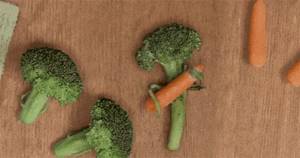
Protein diet menu (Eating routine)
Protein diet for 3 days
The menu for three days can even include only one meat product in the diet. Any protein diet excludes the use of salt when cooking. Therefore, you will have to eat lean meat.
The daily schedule consists of six meals. The daily norm of meat is 500-600 g. You are allowed to eat one type of meat for three days in a row, but you can alternate.
Protein diet for 5 days
The principle of the five-day program is to eat several protein foods, alternating with permitted fruits. A single serving is 200 g. The break between meals should not be more than 2.5 hours.
Protein diet for 7 days
The seven-day system menu includes a small amount of complex carbohydrates in the diet. The body receives them from permitted vegetables. There should be a minimum of five meals a day. The last of which will take place three to four hours before bedtime.
Sample menu for seven days:
- First breakfast: an omelet made from a couple of proteins and green tea.
- Second breakfast: one large apple.
- Lunch: 200 grams of boiled meat and 200 grams of asparagus.
- Afternoon snack: 150 grams of low-fat cottage cheese.
- Dinner: 200 grams of low-fat steamed fish and 150 grams of cabbage salad.
Protein diet for 10-14 days
Due to the long period, 14 days, the menu should be diversified with the following products: legumes, cereals and nuts. Follow a diet consisting of five to six meals.
Detailed menu for every day:
- First breakfast: omelet of cottage cheese, eggs and rice, 150 grams of low-fat cottage cheese or 200 grams of stewed beans.
- Second breakfast: fruit, a couple of cheesecakes or 100 grams of vegetables.
- Lunch: 150 grams of vegetable stew with beef, 200 grams of boiled turkey with rice or 150 grams of veal and 200 grams of salad.
- Afternoon snack: 100 grams of drinking yoghurt, 100 g of cottage cheese or one glass of low-fat kefir.
- Dinner: 200 grams of boiled fish and 150 grams of salad, 150 grams of boiled meat and salad or 200 grams of chicken fillet with asparagus.
Protein diet for 4 weeks
The basis of the nutrition program, which will have to be followed for a month, is taken from the previous schedule. Eat 5-6 times a day.
Daily norm of KBJU
The daily calorie intake is calculated using the Lyle MacDonald formula, or you can use a special nutrition calculator. The energy reserve coefficient, which is necessary for muscle development, is 1.2. Therefore, the resulting number is multiplied by this indicator.
The formula for calculating the daily calorie intake is: weight in kg * coefficient K, kcal/per kg of weight.
The K coefficient depends on the gender of the person, as well as on the speed at which metabolic processes occur in his body.
| Gender | Speed of metabolic processes | Coefficient K, kcal |
| Woman | Slowly | 31 |
| Woman | Fast | 33 |
| Man | Slowly | 33 |
| Man | Fast | 35 |
So, an example calculation:
Daily kilocalorie rate: 75 kg * 35 kcal = 2625 kcal
We multiply the resulting amount by the energy reserve coefficient: 2625 kcal * 1.2 = 3150 kcal.
Thus, it turns out that for a man weighing 75 kg, the daily calorie content should be equal to 3150 kcal. This will allow you to build 2 kg of muscle per month.
After determining the calorie content of the daily diet, let’s consider the correct ratio of nutritional supplements, which make up a sports nutrition complex for muscle development:
- Calculation of the daily protein requirement for men: 2 g per 1 kg of weight. If he weighs 75 kg, then the daily protein requirement is 150 g.
- The daily amount of fat depends on the age of the man:
- 130-160 g – up to 28 years;
- 100-150 g – up to 40 years;
- 70 g – after 40 years.
- The amount of complex carbohydrates is equal to 0.5 kg per day.
Recipes for a protein diet
The recipes below are perfect for your diet program and everyday life.
Cream soup
To prepare you will need:
- Chicken fillet - 400 grams;
- Egg - 2 pcs;
- Spinach - 300 grams;
- Milk - 150 ml;
- Bay leaf - a couple of pieces;
- Parsley;
- Minimum amount of salt and spices.
After boiling the chicken fillet with bay leaf and peppercorns, cut it into small pieces. Cut the eggs into cubes. Cook chopped spinach until semi-soft. Place chopped meat, eggs, spinach in a blender. Add meat broth, milk and whisk until smooth.
Fish soup
You will need:
- White fish - 400 grams;
- Head of red onion;
- Cauliflower - 400 grams;
- Natural yogurt - 2 tablespoons;
- Lemon juice - 1 tablespoons;
- Minimum amount of salt and spices.
After disassembling and cleaning the cauliflower, you need to cut it into small pieces. It is better to cut the fish fillet into large pieces, and the onion into thin rings. Place the ingredients of the dish in a saucepan and cook until the fish is done. After cooking, add yogurt, spices and lemon juice.
Protein salad
You will need for cooking:
- Three eggs;
- Chicken fillet - 200 grams;
- One cucumber;
- Beijing cabbage - 300 grams;
- Natural yogurt - 100 ml;
- Mustard powder;
- Minimum amount of salt and spices.
Boiled eggs and chicken, cut fresh cucumber into small cubes. Finely chop the cabbage. To dress the salad, use natural yogurt in combination with mustard.
Protein omelet
You will need:
- Low-fat cottage cheese - 100 grams;
- Three chicken proteins;
- Green onions;
- Dill;
- Minimum amount of salt and spices.
Using a blender, beat the egg whites until fluffy. Separately, whisk the cottage cheese and dill until smooth. Carefully combine the two mixtures, then place in a non-stick frying pan or bake in the oven.
Chicken in kefir
You will need:
- Chicken fillet - 700 grams;
- Water - 100 ml;
- Low-fat kefir - 100 ml;
- Onion head;
- Minimum amount of salt and spices.
You need to mix water with kefir and pour the mixture over the chicken fillet. You can season it with spices for taste. Place the fillet in the refrigerator for half an hour. Cook in a non-stick frying pan.
Veal steak
You will need:
- Lean veal - 500 grams;
- Olive oil;
- Minimum amount of salt and spices.
It is necessary to cut the meat into steaks, removing the films. The thickness of each steak is approximately 2 cm. Olive oil with spices will serve as a marinade. The meat needs to sit for about an hour. Fry both sides of the steak, then place in the oven for forty minutes.
Expert opinion
Losing weight at home is absolutely possible. But this is not how the question should be posed here. How much and for how long will you be healthier thanks to this weight loss? But here supporters of diets always give in to representatives of the school of developing correct eating behavior. Only in this way are results achieved by patients quickly, without the slightest opportunity to feel hunger, and even with pleasure, and they are then maintained easily, reliably and for a long time (remember any of your habits: how much intelligence, will and energy do you spend on following it?).
In the field of weight loss, psychotherapeutic methods have absolutely no competitors: even super-impressive surgical methods cannot be called “healthy” due to the need to cut a living body. What about the danger of infection, the longevity of the results, and the moral state of the patient?.. Diets cannot be considered a means of losing weight at all. These are courses of therapeutic measures against certain diseases and pathologies that have a short-lived side effect of weight loss. Therefore, once again we want to remind everyone: any diet must be prescribed by a professional, a doctor.
Reviews and results
The protein diet for athletes is extremely popular and is widely used to solve the problem of gaining muscle mass and cutting the body. Reviews about it among athletes are positive, but some of them find it difficult to accurately calculate the caloric content of their diet.
- “... The protein diet is quite often used for me, since I constantly have to adjust my body weight and periodically dry out my muscles. A protein diet belongs to sports diets; it helps both to effectively gain weight and to give relief to muscles and get rid of subcutaneous fat. Of course, the need to constantly calculate the diet and select products for it is somewhat annoying, but the effect is obvious, and there is no other alternative.”
- “... Before competitions, I often resort to protein nutrition, since I need to approach them in optimal physical shape. I approach the formation of a diet very strictly, although my trainer provides me with great help in this. For me, the greatest difficulty is maintaining the frequency of meals, because I have to adjust my whole day around the time of eating, which is sometimes inconvenient.”
